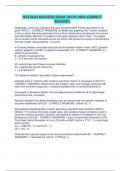Exam (elaborations)
ISYE 6644 MIDTERM EXAM /WITH 100% CORRECT ANSWERS
- Course
- Institution
ISYE 6644 MIDTERM EXAM /WITH 100% CORRECT ANSWERS Graphically, what is an indication that your pseudorandom number generator is "no good" (M1L7). - CORRECT ANSWERS -Example was graphing two "random variates" in the x-y plane that were generated from uniform distributions transformed into normal...
[Show more]



